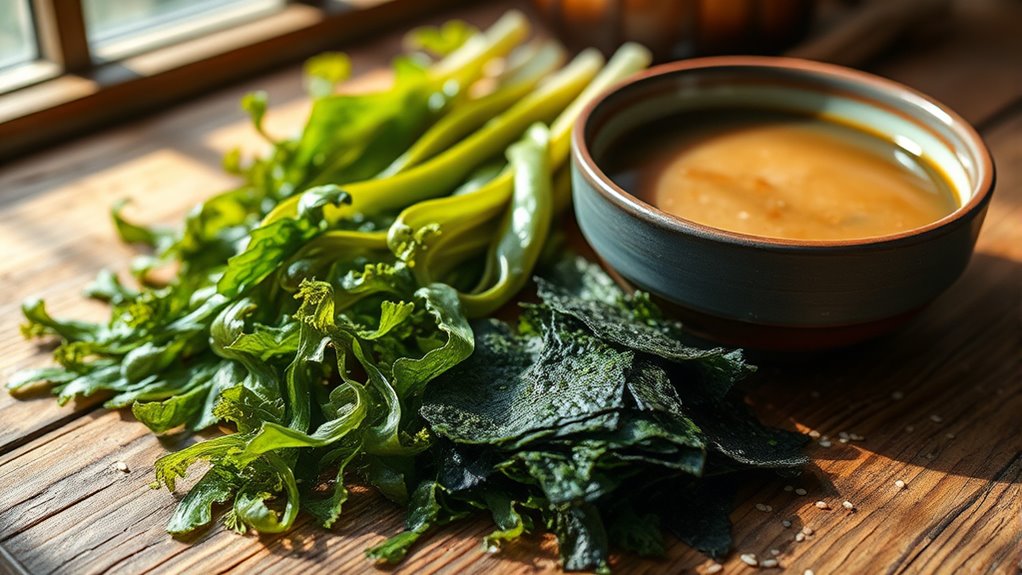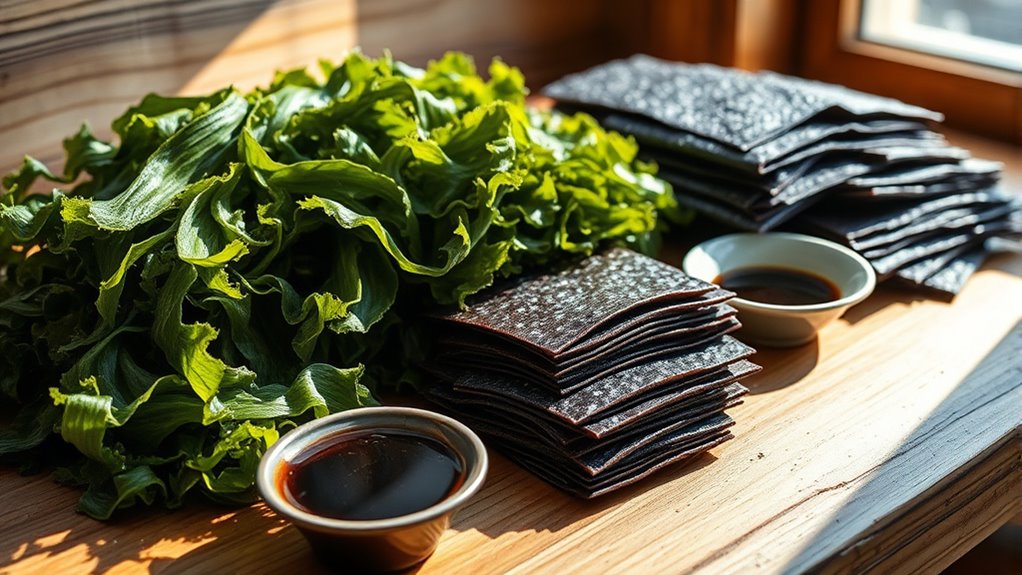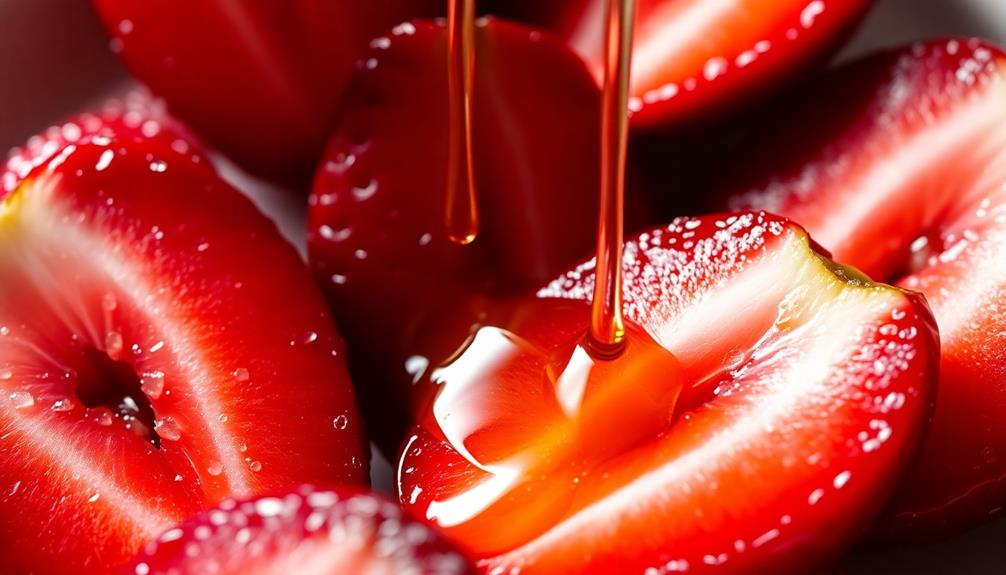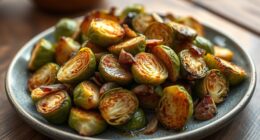You can easily incorporate kelp and nori into your cooking for added nutrition and authentic ocean flavor. Use nori sheets to wrap sushi or as toppings for salads and rice bowls. Simmer kelp in broths to add umami and boost mineral content. Toasted seaweed flakes make great garnishes for soups or stir-fries. Experiment with simple preparations to enhance your dishes and support sustainable eating. Keep exploring for more creative ways to enjoy seaweed’s benefits in your kitchen.
Key Takeaways
- Incorporate nori sheets into sushi rolls, rice bowls, or as snack toppings for added flavor and nutrients.
- Use dried or toasted seaweed flakes to enhance salads, soups, and stir-fries with a savory umami taste.
- Simmer kelp in broths or soups to extract minerals and deepen flavor, supporting healthy digestion.
- Experiment with different preparation methods like toasting, soaking, or blending to suit your taste preferences.
- Choose sustainably sourced seaweed products to promote environmentally responsible cooking and support marine conservation.

Seaweed has become an increasingly popular ingredient in the kitchen, offering a versatile way to add flavor and nutrition to your dishes. Incorporating seaweed like kelp and nori not only elevates your culinary creations but also brings a host of benefits that go beyond taste. One of the key reasons to include seaweed in your cooking is its impressive seaweed health benefits. Rich in essential vitamins, minerals, and antioxidants, seaweed can boost your immune system, support thyroid function, and improve digestion. Its high iodine content helps regulate your thyroid hormones, which is vital for maintaining energy levels and overall metabolic health. Additionally, seaweed is a great source of fiber, aiding in digestive health and helping you feel full longer, making it a smart addition to weight management plans. Eating seaweed can also help you discover new flavors and textures, expanding your culinary repertoire.
Beyond its health perks, seaweed is also a champion of seaweed sustainability. Unlike many land crops, seaweed grows rapidly without the need for fertilizers or freshwater, making it an eco-friendly choice. By choosing to cook with seaweed, you support sustainable harvesting practices that help reduce overfishing and environmental degradation. Many seaweed farms are designed to be environmentally beneficial, improving water quality and providing habitats for marine life. When you incorporate seaweed into your meals, you’re not just nourishing yourself but also contributing to a more sustainable food system. This awareness can influence your choices, encouraging you to seek out responsibly sourced products and support environmentally conscious producers.
Cooking with seaweed is surprisingly simple and rewarding. You can add dried nori sheets to wraps or sushi, sprinkle toasted seaweed flakes over salads, or simmer kelp in broths for a savory umami boost. Its flavor profile ranges from mildly salty to oceanic, which pairs well with a variety of ingredients. For instance, adding chopped nori to rice bowls or stir-fries can introduce a subtle umami flavor that enhances the dish’s depth. Kelp, when simmered into soups, releases a rich, mineral-laden broth that’s both nourishing and satisfying. The key is to experiment and find the preparation methods that suit your taste and dietary needs. Incorporating seaweed into your diet can also help you discover sustainable seafood options, promoting environmentally friendly choices.
Frequently Asked Questions
How Should I Store Dried Seaweed to Keep It Fresh?
To keep dried seaweed fresh, store it in an airtight container in a cool, dark place. Proper dried seaweed storage prevents exposure to moisture and sunlight, which can cause spoilage. Make sure the container is sealed tightly after each use. Avoid storing it near heat sources or in humid areas. This way, you’ll preserve seaweed freshness longer and enjoy its flavor and nutrients whenever you cook.
Can Seaweed Be Used in Desserts or Sweet Dishes?
Imagine a surprise in your dessert—yes, seaweed can be used in sweet seaweed recipes. Seaweed desserts add a unique umami twist and natural saltiness that balances sweetness beautifully. You can incorporate powdered nori or kelp into custards, jellies, or even cakes for a subtle sea flavor. Experiment with sweet seaweed recipes to create innovative treats, blending oceanic flavors with your favorite sweet dishes effortlessly.
Are There Any Allergies Associated With Eating Seaweed?
You should be aware that some people have a seaweed allergy, and symptoms can include itching, swelling, or difficulty breathing. Seaweed cross reactivity might occur if you’re allergic to other shellfish or algae, so watch for symptoms like hives or stomach upset after eating it. If you suspect a seaweed allergy or experience symptoms, consult an allergist for proper testing and guidance to avoid reactions.
What Are the Best Sources for High-Quality Seaweed Products?
You should look for reputable sources that prioritize sustainable seaweed cultivation methods, guaranteeing high quality. Organic seaweed is cultivated without synthetic fertilizers or pesticides, offering cleaner options, while conventional seaweed may still be safe but varies in quality. Check labels for certifications and buy from trusted suppliers or specialty health stores. This way, you make certain you’re getting nutrient-rich, safe, and environmentally friendly seaweed products for your kitchen.
How Can I Incorporate Seaweed Into Traditional Non-Asian Recipes?
Did you know seaweed contains more calcium than milk? To incorporate seaweed into traditional recipes, try adding chopped nori or kelp to pasta dishes for a umami boost or sprinkle shredded nori in salads for added texture and flavor. You can also blend seaweed into pesto or soups, giving your non-Asian recipes a nutritious twist. It’s a simple way to enjoy the health benefits of seaweed every day.
Conclusion
Just like the ocean’s endless depths hold treasures waiting to be discovered, your kitchen can become a world of culinary adventure with seaweed. Embrace these humble greens as your guiding stars, transforming simple dishes into nourishing voyages. Remember, every time you cook with kelp or nori, you’re exploring a vast underwater universe that connects you to nature’s wisdom. Immerse yourself boldly — your palate and soul will thank you for the journey.










